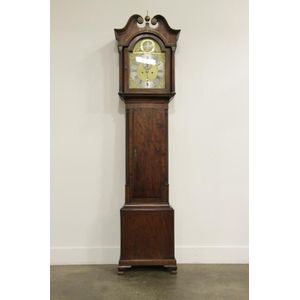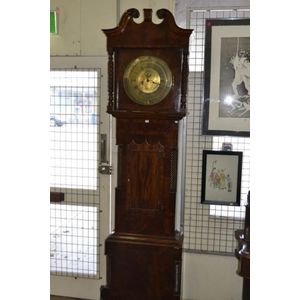English Oak Long Case Clock by Wm. Green, Doncaster
You must be a subscriber, and be logged in to view price and dealer details.
Subscribe Now to view actual auction price for this item
When you subscribe, you have the option of setting the currency in which to display prices to $Au, $US, $NZ or Stg.
- Ebony - Ebony is a close grained timber, black in colour. It has a fine texture which can be polished to a high gloss, making it suitable for venereering, inlay and stringing and its use as solid timber is resticted to small decorative items and ornamental decoration, such as chess pieces and musical instrument parts. The term "ebonised" means "faux ebony", timber that has been darkened during the polishing process to resemble ebony.
- Hood - In longcase clocks, the hood is the wooden case that surrounds the works and dial, and includes the glass front, which is usually hinged, so the door can be opened to wind the clock or adjust the time. In 18th and 19th century longcase clocks the hood usually slides forward for removal, allowing access to the works.
- Mahogany - Mahogany is a dense, close grained red-coloured timber from the West Indies and Central America. It was first imported into Europe in the the early 18th century and its use continued through the 19th century. It was popular for furniture making because of its strength, the wide boards available, the distinctive grain on some boards, termed flame mahogany and the rich warm colour of the timber when it was polished.. The "flame" was produced where a limb grew out from the trunk of the tree, and this timber was usually sliced into veneers for feature panels on doors, backs and cornices.
Some terms used to describe mahogany relate to the country from which it originally came, such as "Cuban" mahogany, "Honduras" mahogany etc. However unless the wood has been tested the names assigned are more a selling feature, rather than a true indication of the timber's origin. - Date Aperture - A date aperture is a cut out section in the face of a watch or clock, displaying the day of the month.
- Oak - Native to Europe and England, oak has been used for joinery, furniture and building since the beginning of the medieval civilisation. It is a pale yellow in colour when freshly cut and darkens with age to a mid brown colour.
Oak as a furniture timber was superceded by walnut in the 17th century, and in the 18th century by mahogany,
Semi-fossilised bog oak is black in colour, and is found in peat bogs where the trees have fallen and been preserved from decay by the bog. It is used for jewellery and small carved trinkets.
Pollard oak is taken from an oak that has been regularly pollarded, that is the upper branches have been removed at the top of the trunk, result that new branches would appear, and over time the top would become ball-like. . When harvested and sawn, the timber displays a continuous surface of knotty circles. The timber was scarce and expensive and was used in more expensive pieces of furniture in the Regency and Victorian periods. - Calendar Aperture - A calendar aperture on a clock refers to a small window on the clock face that displays the day, month or year or all of these. The aperture is usually located on the clock's dial with the date data recorded on a wheel which is designed to rotate to show the correct date information.Some clocks have a manual adjustment for the date, while others are designed to automatically adjust for the date, including for leap years. The calendar aperture is a useful feature found on clocks from the 16th century, and on many types of clocks, including wall clocks, alarm clocks and wristwatches.
This item has been included into following indexes:
Visually similar items

An oak longcase clock by Robert Mason of Kelso, circa 1820-1830, with swan neck hood, the dial painted with floral spray, 205 cm high, 47 cm wide. Provenance: collection of Michael Galloway, Sydney

An early 19th century mahogany cased grandfather clock the brass dial with a silvered chapter ring signed Geo. Bruce London. Height 218 cm. Width 45 cm. Depth 22 cm

A Corforth long cased clock, architectural case with two torsed column around the dial and brass finials, on raised feet, with weights and pendulum. Height 231 cm

An imposing mahogany long case clock with brass dial and goose neck pediment
